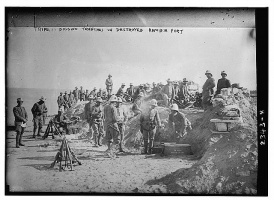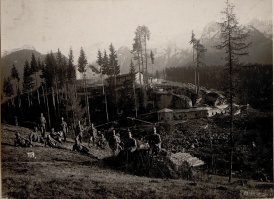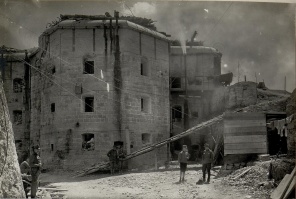Introduction↑
The French built some of the best fortresses in Europe in the 17th century and set the standard on fortifications not only for France, but for the rest of Europe. French engineers in the 19th century still looked to the famous 17th century French engineer Sébastien Le Prestre de Vauban (1633-1707) for their designs, although fortifications also went through various upgrades because of advances in weapons technology. This changed how engineers designed, built, and incorporated fortifications into a nation’s strategic planning. Fortifications during World War I did not lose their importance, nor did European militaries view them as irrelevant.
Strategic Considerations↑
European nations, to varying degrees, relied on fortifications to “protect … lines of communications and prevent bridgeheads” and secure their borders.[1] Belgium built its fortifications around Namur and Liège to protect its frontier so the army could position itself in the center of the country and delay any invaders. France’s defense, focused on an attack from the new German state, depended on 166 fortifications built between Verdun and Toul. By 1900, Italy viewed France as its most probable opponent and concentrated its fortifications against that country, leaving bare its border with Austria-Hungary for much of the prewar period, only beginning to modernize fortresses there in 1904. Austria-Hungary was strengthening its fortresses just as Italy began to drift from the Triple Alliance. After beating France in the Franco-Prussian War (1870-1871), Germany began building the fortifications around Metz to secure its newly won western territories.
Central European nations did not ignore Eastern Europe. Germany, Austria-Hungary, and Russia all studied ways to improve their strategic positions. Russia learned from its defeat in the Russo-Japanese War (1904-1905) that “tactical offensive[s]” during engagements led to victory and thus questioned the use of fortifications.[2] In preparation for a conflict with Germany, Russia upgraded its field army, while also adding improvements to some of its Polish fortifications. The outcome was the worst possible: Weak offense and weak defense. Germany focused its upgrades on the Alsace-Lorraine region until 1912, when the general staff realized it could no longer ignore Russia. Germany therefore allocated more than 210 million marks to upgrade fortifications on its eastern borders, such as in Graudenz and Posen. Renovations began in 1913, but had not been completed by the time the war broke out.
Austria-Hungary, pre-occupied with Italy, paid little attention to the Balkans until 1904. Along the Austria-Russian border, the fortress city at Przemyśl was updated late in the 19th century, but by 1914, half of its fortifications were outdated. After “Austria-Hungary risked war against Serbia, Montenegro and Russia” during the First Balkan War (1912-1913), it subsequently spent 55 million crowns on fortifications in the Balkans and Galicia.[3] With the exception of its Italian border, Austria’s fortifications were generally outdated. Each nation, therefore, looked toward its fortresses according to perceived threats.
Technological Advancements↑
Technological advances in arms and construction techniques in the mid-to-late-19th century and up through World War I forced engineers to change their designs if the forts were to remain useful. Rifled artillery and high-explosive shells required engineers to consider “much deeper ‘defence in depth.’”[4] Artillery could quickly incapacitate fortresses built with traditional masonry materials; French engineers, for example, having begun construction on the fortifications using masonry techniques, ultimately switched to reinforced concrete and steel. Fortresses entered a form of arms race with artillery and siege mortars. At first, field and permanent fortifications complimented each other. Field fortifications, however, would later surpass permanent fortifications in importance.
The Western Front↑
World War I started on the Western Front when Germany implemented its adapted version of the Schlieffen Plan. Named after its chief architect, Chief of the German General Staff Alfred von Schlieffen (1848-1916), the plan sought to overcome Germany’s strategic dilemma of a two-front war by first quickly defeating France, then moving to concentrate on Russia. Schlieffen, worried that Germany could not rapidly break through France’s strong fortifications along the German border, planned to flank French fortifications by invading Belgium to the north and then swinging south into France. When the war began, the plan at first appeared to work. Germany quickly destroyed the Belgian forts around Namur and Liège, along with many modern French fortresses, prompting the French to take heavy guns from its remaining forts to augment the field armies’ insufficient guns. This reaction would have consequences for the French during the Battle of Verdun in 1916.
When German Chief of the General Staff, General Erich von Falkenhayn (1861-1922), launched the offensive against Verdun in February 1916, its surrounding fortresses were not fully operational because many of their heavy guns and manpower had been removed. General Henri-Philippe Pétain (1856-1951), commander of the French Second Army south of Verdun and the man responsible for the city’s defense, quickly saw that the forts had to be restored to their full status to survive the German offensive. Pétain’s actions not only helped enable the French to stave off defeat and beat the Germans at Verdun, but also demonstrated the continued value of fortresses.
The Eastern Front↑
Because Russia had opted to update its army and fortresses at the same time, neither were fully ready when the war broke out. Russia’s failures became evident when it suffered a disastrous defeat at the Battle of Tannenberg. By 1915, Germany had captured all the region’s fortresses.
Austria-Hungary’s position was precarious at the start of the war. Its efforts into Serbia were stalled, and its offensive into Galicia was defeated. Despite its offensive failures, the fortress city of Przemyśl held out against the Russian siege for over four months, while none of Austria’s other fortresses fell. To the southwest, the mountainous terrain along the Italian-Austrian border limited Italian offensives options to the Isonzo River Valley, which was relatively free of fortifications. Despite the geographic opportunity for an advance, an inept Italian army, combined with stiff Austrian resistance, caused the Italian-Austria front to remain stagnate for large portions of the war. What the fighting along the Western and Eastern Fronts showed were that fortifications could be effective if they were modern, fully gunned, and fully manned.
Conclusion↑
The effects of forts on various First World War campaigns convinced some Europeans nations of their continued value, despite their uneven battlefield record. The Germans’ ability to destroy fortifications in Belgium showed forts’ weakness against superior firepower. The survival of the French fortress-city of Verdun, however, suggested the potential effectiveness of fortifications when fully operational. Fortress effectiveness on the Eastern Front was also questionable. Various Russian fortresses fell, yet nearly all Austria-Hungary's fortifications resisted capture at the start of the war. Even after the war, the Belgian construction of Eben-Emael, France’s Maginot Line, and Germany’s “Westwall” show that many Europeans continued to value fortifications despite advancements in weaponry and the forts’ “ambiguous” record in the war.[5]
Miguel A. Lopez, United States Air Force Academy
Section Editor: Mark E. Grotelueschen
Notes
- ↑ Stevenson, David: Fortifications and the European Military Balance before 1914, in: The Journal of Strategic Studies 35/6 (2012), p. 831.
- ↑ Joll, James / Martel, Gordon: The Origins of the First World War, Harlow 2007, pp. 304-305.
- ↑ Stevenson, Fortifications 2012, pp. 836-837.
- ↑ Griffith, Paddy: The Vauban Fortifications of France, New York 2006, pp. 56-57.
- ↑ Stevenson, Fortifications 2012, p. 856.
Selected Bibliography
- Donnell, Clayton: The fortifications of Verdun, 1874-1917, Botley, Oxford 2010: Osprey Publishing.
- Herrmann, David G.: The arming of Europe and the making of the First World War, Princeton 1996: Princeton University Press.
- Joll, James / Martel, Gordon: The origins of the First World War (3 ed.), Harlow 2007: Pearson Longman.
- Stevenson, David: Fortifications and the European military balance before 1914, in: Journal of Strategic Studies 35/6, 2012, pp. 829-859.
- Strachan, Hew: The First World War. To arms, volume 1, Oxford 2001: Oxford University Press.












